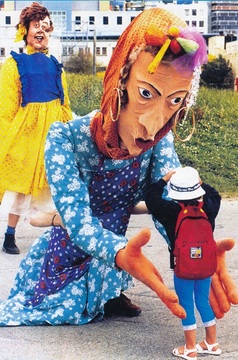1996 Aotearoa Maori Performing
Arts Festival
held Rotorua 22nd – 25th february 1996
at
arawa park racecourse.
The stylised image of the Huia symbolizing Excellence &
Beauty.
Comperes for the festival were: Temuera Morrison, Piripi
Munro and Maureen Waaka.
Te Arawa Host Committee ;
Charlie Clark, Parehuia Hakaraia, Piwai Tuhua, Watu Mihinui, Rota Mihaka, Ngaroma Grant, Yvonne Edwards, Karen Te O Kahurangi Grant, Trevor Maxwell, Monty Morrison, Tuku O’Brien, John Merito, Maata Hamiora, Tawini Rangihau and James Hamiora.
The Governor-General of NZ – Dame Cath Tizard was welcomed by
Ngati Whakaue as part of the opening ceremony.
Competition commencing at 9.30am finishing at 7.30pm on Day
1, an evening programme followed at the Sportsdrome. “Te Ope o Rehua Showcase”
featured performances from Ahurewa, Tribal Lynx, ‘Tina Tuna’, Aotearoa Wananga,
Brisbane Maori and Hawaiian, Aboriginal and Canadian Indian groups. The Compere for the evening was Temuera
Morrison.
Day 2: 9.00 am to 7.30 pm. followed by a social function at
the Sportsdrome with band ‘Azziz’
Day 3: The finalists commence competition for the Aggregate
Title.
Above information is from the official programme for the festival.
Top 4 Te Arawa teams from the 1995 Regionals, and eligible to compete,
were Ngati Rangiwewehi, Tuhourangi Ngati Wahiao, Te Mataarae I Orehu and Nga
Pumanawa. In Daily Post, 6th March 1995, p.3.
Winners: Ngati
Rangiwewehi also winners of Te Arawa Cultural Competition, went on to win Aotearoa Maori Performing Arts
Festival , DP 24 Feb 1996, p1 & 4 “winners for the first time since 1983” went
to the South Pacific Festival of Arts in Western Samoa on 3rd Sept.
1996. Daily Post on 3/3/1995, 15 Dec 1995, 23 January 1996-24th January 1996.
1990-1995
1990 – At Waitangi as part of
the Waitangi Day Celebrations. Overall Winner 1990: Te Roopu Manutaki.
1992
– At Ngaruawahia – Ngati Rangiwewehi won 2nd place overall and
Howard Morrison Jnr. won the Male Stage Leader award. Daily Post 18 Feb 1992, p. 1. Overall Winner 1992 : Te Waka Huia
1994
– At Hawera. Ngati Rangiwewehi was rated in the Top 4 again. A place of
familiarity for the group, who have been in the top for 9, out of the last 11
festivals. See all the photographs and
highlights in Mana magazine, Feb/Mar 1994 p. 20. Overall Winners 1994 : Te Waka Huia.
1997-1999
1997 Te Arawa Festival in Daily Post 11 Mar 1997, 17 Mar 1997 and 18
Mar 1997. Teams to compete in Aotearoa Maori Performing Arts held 1998 in
Trentham: Tuhourangi /Ngati Wahiao ; Te
Wananga o Aotearoa ki Rotorua ; Ngati
Rangiwewehi ; Te Mataarae I Orehu.
1998 Aotearoa Maori Performing Arts Festival, in Daily Post
16 Mar 1998, 23 Feb 1998, 24 Feb 1998. In the top six, for the festival, were
Ngati Rangiwewehi in 3rd Place, Te Mataarae I Orehu in 5th
Place. Overall winners: Te Kapa Haka o Te Whānau-a-Apanui.





